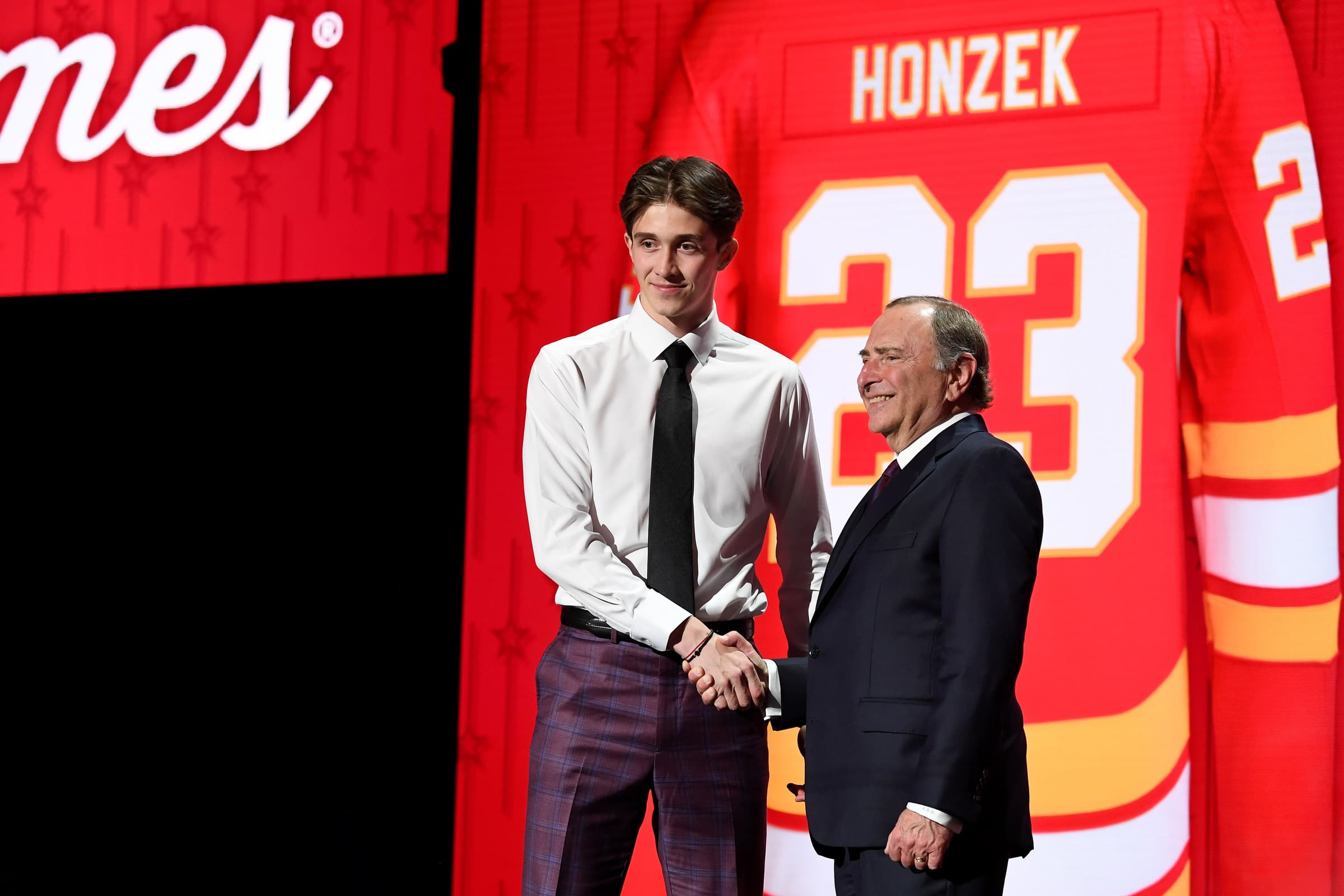Nation Sites
The Nation Network
FlamesNation has no direct affiliation to the Calgary Flames, Calgary Sports and Entertainment, NHL, or NHLPA
Rarely do Calgary Flames signees get as many bonuses as Samuel Honzek did

Photo credit: Christopher Hanewinckel-USA TODAY Sports
Brought to you by odds site Betway!
In the National Hockey League, it’s not uncommon for general managers to throw wacky amounts of money at players to get them to sign with their teams. However, entry-level contracts have specific rules, with salaries and signing bonuses capped, leaving a small variation within a contract’s performance bonuses available to lure a player to sign.
On Wednesday, the Calgary Flames announced the signing of 2023 first-rounder Samuel Honzek. He’s just the 10th player signed by the Flames to an ELC since 2013 to have over $1 million in potential performance bonuses included as a signing incentive.
How performance bonuses work
The “regular” cap hit of an NHL contract is based on the average annual value of a player’s combined NHL salary and signing bonus. For entry-level deals, there’s an entry-level cap of $950,000 per year. (It was $925,000, but it was bumped up in the last CBA extension starting with the 2022 NHL Draft class.)

But performance bonuses are only paid if a player hits the thresholds laid out in the CBA and their own contract, so they only count against the cap if they’re paid out. So while base salary and signing bonuses are capped, performance bonuses allow a team to dangle a bit more potential moolah at a player they may be trying to sign. The current maximum is $3.5 million per season, which is split between $1 million of “A”-bonuses (based on a player’s performance relative to his team) and $2.5 million of “B”-bonuses (based on a player’s performance relative to the rest of the league).
However, if you’re a GM and you decide to throw oodles of potential bonuses at a youngster, agents will say “Hey, my guy should get that, too.” So as a result, generally ELC bonuses have followed a pretty straight-forward pattern: first-overall picks get max bonuses and as you get further into the first round, draft selections usually get less and less. Heck, most late first-rounders – like Jakob Pelletier, Connor Zary, Morgan Klimchuk and Emile Poirier over the past decade – don’t get performance bonuses included in their deals at all.
With that preamble out of the way…
The 10 players who hit seven digits in bonuses
$6.9 million – Sam Bennett
The fourth-overall pick in 2014, and the highest selection the Flames have ever made in Calgary, Bennett got $2.3 million in potential bonuses for all three years of his ELC.
$5.7 million – Corban Knight
Remember Corban Knight? A highly sought-after college free agent, the Flames shelled out max bonuses at the time to get him, with $2.85 million in potential bonuses for both years of his ELC.
$2.775 million – Johnny Gaudreau
A fourth-round pick, typically guys like Gaudreau would’ve gotten zilch in terms of ELC bonuses. But the Flames were trying hard to get him to leave college, and so he got some nice bonuses. He had one year of no bonuses, followed by $925,000 and $1.85 million in his subsequent seasons.
$2.55 million – Matthew Tkachuk and Sean Monahan
Both of these youngsters were sixth overall picks, Monahan in 2013 and Tkachuk in 2016. So the Flames gave them identical deals, with $850,000 in bonuses in all three seasons of each of their deals.
$1.7 million – Matt Coronato and Spencer Foo
Coronato was the 13th overall pick in the 2021 NHL Draft. The Flames gave him slightly more bonuses than most first-rounders of that slot – none in year one, $850,000 in each of the next two – to lure him away from college hockey.
Speaking of college hockey, Foo was a highly-touted college free agent and the Flames gave him $850,000 in potential bonuses in each of his two ELC years to get him to sign.
$1.5 million – Samuel Honzek
$1.275 million – Juuso Valimaki
$1.275 million – Juuso Valimaki
Both of these guys were 16th overall picks, Valimaki in 2017 and Honzek in 2023. Two things happened here: first, the maximum amount of “A”-bonuses was bumped up in the 2020 CBA extension from $850,000 to $1 million, which likely caused a bit of inflation between Honzek and Valimaki’s deals. The Flames also can potentially utilize two slide years in Honzek’s deal because he signed so quickly, so it makes sense that he might have been compensated for doing so with the possibility of slightly more bonuses.
Honzek got three years of $500,000 in potential bonuses, Valimaki got $425,000 per season.
$1,137,500 – Mark Jankowski
As a late first-rounder, usually Jankowski would have received zero ELC bonuses in his deal. But since he was a pretty good college player and the Flames wanted him to put pen to paper pronto, he got bonuses included. He got $500,000 in his first season and $637,500 in his second season.
Breaking News
- Scotia Place: a street-level look at December construction progress
- Beyond the Boxscore: Flames come out swinging in big 6-3 win over Golden Knights
- Rasmus Andersson on remaining a Flame: ‘It takes two to tango’
- Ryan Lomberg’s big goal and big fight highlight Flames win over Vegas
- Instant Reaction: Flames overwhelm Vegas early, hold on for win
